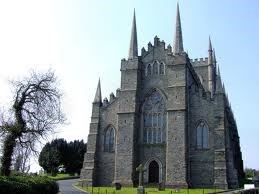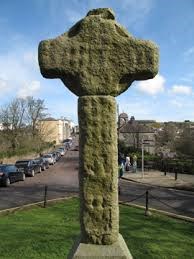
Cathedral Hill in Down has been a focus of Christian worship for almost as long as Christianity has been in Ireland. Tradition has it that Saint Patrick brought the Faith to the country in the early part of the fifth century. Patrick was a North Briton who was captured by a party of raiding Irishmen and brought to Ireland as a slave reputedly a a swineherd on the slopes of Slemish Mountain neat Ballymena, Co. Antrim. During his years of captivity, he spent much time in prayer and would say as many as one hundred in a day, as he tells us in his Confession.
However, after six years of slavery and hardship, he escaped and boarded a ship. We cannot say if the ship was bound for Britain or Gaul, but we do know that he was re-united with his family. Patrick then tells of a dream in which a man named Victoricus brings him a letter. It was headed 'The Cry of the Irish.' While reading it, in his imagination he heard voices calling: 'Holy Boy, we are asking you to come and walk among us again'. Thus far, we have Patrick's own story, told in his Confession.
Patrick's two principal biographers, Muirch and Tirechan, both writing some centuries later, take up the story. We are told that Patrick landed first on the coast of Wicklow and from there travelled northwards as far as Strangford Lough where he landed at the mouth of the River Slaney near Saul.
Here he met the local chieftain, Dichu, whom he converted to Christianity and who gave him a barn as his first church. The present Church of Ireland church at Saul, 2 miles distant from Down Cathedral, was built in 1932 to commemorate the fifteen hundredth anniversary of Patrick's arrival. Patrick spent many years travelling among the Irish, converting the people to Christianity, consecrating bishops and founding churches as he went.
Many years later, nearing the end of his life, he returned to Saul but let it be known that he wished to die in Armagh. He began to make his way there, but was interrupted, however, by the angel Victor telling him to return to Saul. There, in his last moments, he was tended by Bishop Tassach of Raholp. Muirchu describes his burial with tremendous sense of drama: 'Let two untamed oxen be chosen and let them go wherever they will with the cart that carries your body and wherever they stand still, there a church in honour of your body shall be erected . . . untamed oxen were chosen and they steadily drew the cart containing the holy body placed on their necks and, guided by the will of God, they went out to Dun Lethglaisse (Down) where Patrick lies buried.'
One cannot be certain of the exact spot of his burial, but the Memorial Stone, put in position by the Belfast Naturalists' Field Club in 1900, traditionally marks his grave. It is a slab of granite from the nearby Mourne Mountains.
In the Early Christian period, Down was the seat of the kings of the Dal Fiatach, the Irish people who occupied the southeast of modern County Down. The first bishops would have been members of this family and they would not have exercised any jurisdiction beyond their own territory.
The year 753 marks the earliest reference to the death of an Abbot of Down. From this date onwards we can trace a fairly complete succession of abbots and bishops of the Celtic Monastery which occupied the Hill.
The monastery was plundered by Vikings on a number of occasions and by 1016 there was a stone church and round tower, subsequently burned by lightning.
The Round Tower was pulled down in 1790 and its masonry incorporated in the restoration of the Cathedral. In the Celtic Church, the possession of the tomb of an illustrious saint was an important factor in the growth and wealth of a monastery. Pilgrims flocked from all over Ireland, and farther afield, to worship at the shrine of Saint Patrick.
After the Normans came to Ireland, John de Courcy, one of their knights, set out for Down to conquer the north and possess the tomb of Saint Patrick. In 1177 de Courcy ousted Rory Macdunleavy, the last king of the Dal Fiatach.
As was the custom of the time, de Courcy founded a number of monasteries in Down and elsewhere, but chief among these was the Benedictine Monastery on Cathedral Hill, which, in deference to the local people, he dedicated to Saint Patrick. He invited monks from St Werburgh's in Chester to provide the first Prior and to become the founding community.
By now, the tradition of the hill being the burial place of Saints Brigid and Columcille had been added to the canon, giving rise to the well-known couplet:
In Down, three saints one grave do fill,
Patrick, Brigid and Columcille.
It is generally accepted that the main walls of the Cathedral date from the years after 1220. Then the monks, in a petition to Henry III, King of England, referred to the fact that the House of Saint Patrick, which had often been destroyed and burned, was being rebuilt again. Further destruction took place during the wars with Edward Bruce in 1316 and finally, on the suppression of the monasteries in 1541, the Cathedral was laid waste. Notwithstanding its ruinous state which lasted until 1790, King James I granted a Charter to the Cathedral in 1609, providing for a Dean and Chapter. The Charter also decreed that the Cathedral should be dedicated to the Holy Trinity, as the former Celtic church had been before the arrival of de Courcy. Rather than lose the connection with Patrick, the name began to be used for the growing town, which assumed the name Downpatrick.

Although successive deans continued to be installed within the ruined walls, there were no funds to rebuild the Cathedral until 1790 when Wills Hill, the Earl of Hillsborough (and afterwards first Marquess of Downshire), along with the then Dean, the Honourable and Reverend William Annesley, provided the impetus to commence the restoration.
Dean Annesley contributed £300 annually from the income of the Deanery and, by Act of Parliament, bound his successors to do likewise, in order to provide a fund to enable Divine Service to be carried on in the Cathedral. The Marquess of Downshire wrote to many of his parliamentary colleagues, to all the Irish bishops and to the nobility and gentry of the county in order to raise subscriptions. He even obtained a gift of £1,000 from King George III. Although it is apparent from the records that Divine Service was held in the Cathedral prior to 1818, it was not until that year that it was consecrated; the tower was completed in 1829.
When the Church of Ireland was disestablished in 1870, the Cathedral Chapter found itself totally disendowed and without funds. Since then the Cathedral of the Diocese of Down has had to rely on voluntary subscriptions for its upkeep and maintenance.
Over the years, there have been many periods when the Chapter Book records that the Cathedral was closed for repairs. But none was as far-reaching as the recent renovations which took place in 1986/7. Attacks of rot were so extensive that the Cathedral Board, acting on professional advice decided to remove almost the entire interior plaster walls and vaulting. What the visitor sees now is an almost entirely new interior, a replica of that which it replaced. The cost of this was upwards of £750,000 which was all raised voluntarily.

In December 2013 the 1,100-year-old High Cross that stands in front of Down Cathedral was moved to nearby Down County Museum where it will be cleaned, drawn and photographed by a team of experts before becoming the centrepiece of a new extension due to be built soon.
The intricately patterned Mourne granite cross, carved around AD 900 as a "prayer in stone", is of historical, cultural and religious significance. New photographs and scans of the cross already show details of the carvings which have not been apparent in recent years, leading to revised interpretations of the biblical scenes depicted on its front and rear faces.
Its first location is believed to have been the early medieval monastery on the Hill of Down. Following the Reformation, the High Cross was taken down and was used as Downpatrick's market cross. It was damaged in the busy town centre location and eventually dismantled and its parts dispersed around the town.
In the 1890s, the parts were gathered together by Francis Joseph Bigger and reconstructed outside Down Cathedral, with the help of subscriptions from donors.
The High Cross will be replaced in 2014 by an exact replica made by a Kilkeel stonemason using granite blasted from a local quarry at Thomas Mountain.
Chronology
432 Arrival of Patrick in Ireland
461 Death of Patrick
753 Death of Scannlan first recorded Abbot
1016 A stone church and round tower burned by lightning
1148 Death of Malachy, first reforming Bishop
1177 Arrival of John de Courcy
1183 Founding of Benedictine Monastery dedicated to Saint Patrick
1220 Monks petition Henry III, referring to the building of their Cathedral
1316 Cathedral plundered during Bruce wars
1541 Suppression and dissolution of monasteries
1609 Grant of Charter to Cathedral by James I
1790 Commencement of restoration by Wills Hill, first Marquess of Downshire and Dean William Annesley
1818 Cathedral consecrated for Divine Worship
1829 Completion of tower
1870 Disestablishment of Church of Ireland and consequent loss of endowments.
1958 Revival of Saint Patrick's Day Pilgrimage Service
1986/1987 Complete restoration of Cathedral at a cost of £750,000
2013 High cross removed to the museum & replaced with a replica in 2014.
Information courtesy of Down Cathedral website
The Church Micro IE series is open to everyone; if you have a church you would like to place a cache at then please contact THE_Chris through Geocaching.com. He keeps track of the numbers of the churches and he will give you the general format for the cache page. In the UK there are #1500 caches in the series so we have some catching up to do! If you currently have a published cache at a church that you would like to include in the series get in contact and we can add it.
